IEU'S FEATURED TOPIC IN UKRAINIAN ART AND ARCHITECTURE
IMPRESSIONISM IN UKRAINIAN PAINTING
An important movement in painting that arose in France in the late 1860s and is linked with artists such as Claude Monet, Camille Pissarro, Auguste Renoir, and Alfred Sisley (who sought to capture with short strokes of unmixed pigment the play of sunlight on objects), impressionism had a strong influence on Ukrainian painting. The first Ukrainian impressionists appeared at the end of the 19th century. Perhaps the earliest representative of impressionism in Ukrainian art in eastern Ukraine was Petro Levchenko who studied in Paris in the 1890s and subsequently started painting in impressionist style. In Western Ukraine the first Ukrainian pinters attracted to impressionism were graduates of the Cracow Academy of Fine Arts, where they had studied under such well-known Polish painters as Jan Stanislawski, Leon Wyczolkowski, and Jacek Malczewski. Oleksa Novakivsky, who later embraced a symbolic expressionism reminiscent of Vincent van Gogh and Ferdinand Hodler, was one of the first Ukrainian impressionists. Ivan Trush, who preferred to work with grayed colors, adopted impressionism only partly. Mykola Burachek captured the sunbathed colors of the Ukrainian steppe. Mykhailo Zhuk and Ivan Severyn introduced decorative elements of secession into their impressionist works. Impressionism was a major trend in Ukrainian painting until the early 1930s. Its other leading exponents were Oleksander Murashko, Vasyl H. Krychevsky, Abram Manevich, Fedir Krychevsky, Petro Kholodny (landscapes and portraits), Mykola Hlushchenko, and Oleksii Shovkunenko. Then Mykhailo Dmytrenko, Mykola Nedilko, Mykola Krychevsky, and Mykhailo Moroz continued the tradition of Ukrainian impressionism in emigration... Learn more about impressionism in Ukrainian painting by visiting the following entries:
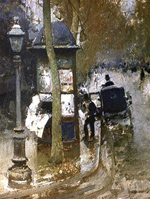
|
LEVCHENKO, PETRO, b 11 July 1856 in Kharkiv, d 27 January 1917 in Kharkiv. Painter and pedagogue. He studied art in Kharkiv under Dmytro Bezperchy, at the Saint Petersburg Academy of Arts (1878-83 under, among others, Volodymyr Orlovsky), and later in Paris and Rome. From 1886 he lectured at the Kharkiv Painting School. He was a member of the Society of South Russian Artists and a participant in almost all of the exhibitions of the Peredvizhniki (1886-1904), but following his visit to Paris in the 1890s, his works displayed strong influences of impressionism. Levchenko did some 800 landscapes, primarily of Ukraine (such as A Street in Putyvl or The Yard of Saint Sophia Cathedral), but also painted abroad (such as A Street in Paris and Seacoast: Naples). He also painted still lives and genre paintings and was perhaps the most accomplished master of interior art in Ukraine of his time. Levchenko was not properly recognized for his achievements during his lifetime. Only in 1919 a large posthumous retrospective exhibition of 700 of his paintings was held in Kharkiv. Monographs about him were written by M. Pavlenko (1927), Yu. Diuzhenko (1958), and M. Bezkhutry (1984)...
|
| Petro Levchenko |
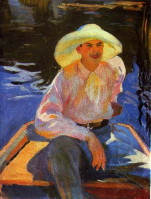
|
MURASHKO, OLEKSANDER, b 7 September 1875 in Kyiv, d 14 June 1919 in Kyiv. Painter. He studied at the Kyiv Drawing School (1891-4) and later, under Ilia Repin, at the Saint Petersburg Academy of Arts (1894-1900) where he was awarded the Academy's gold medal in 1900 for his diploma painting Burial of a Kish Otaman. As part of his prize, he was sent to study in Paris (1902-4); later he also studied at the Munich Academy of Arts. In 1907 he settled in Kyiv, where he taught painting at the Kyiv Art School (1909-12) and at his own studio (1912-17). In 1909 he exhibited his canvases in Paris, Amsterdam, and at the international exhibition in Munich where his painting A Carousel (1906) was awarded the main prize. He was a cofounder of the Ukrainian State Academy of Arts in 1917 and served as its professor. Murashko's style evolved from the realism of the Peredvizhniki school into a vivid, colorful impressionism. His paintings have been praised by critics for their psychological depth. Murashko established an international reputation and had a strong influence on the development of Ukrainian art in the 20th century. He was murdered in Kyiv by unknown assailants... |
| Oleksander Murashko |
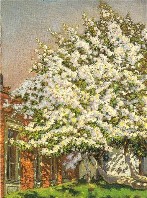
|
BURACHEK, MYKOLA, b 16 March 1871 in Letychiv, Podilia gubernia, d 12 August 1942 in Kharkiv. Impressionist painter and pedagogue. Burachek studied in Kyiv and graduated from the Cracow Academy of Fine Arts in 1910. His first exhibit was held in 1907. In 1910-12 he worked in the studio of Henri Matisse in Paris. In 1917-22 he served as professor at the Ukrainian State Academy of Arts in Kyiv and then at the Kyiv State Art Institute and the Lysenko Music and Drama Institute in Kyiv. From 1925 to 1934 he was rector of the Kharkiv Art Institute and then returned to Kyiv. A master landscape painter, he rendered Ukrainian landscapes in a colorful, impressionist style. He also designed stage sets. As an art scholar, Burachek made a significant contribution to the study of Taras Shevchenko as an artist and wrote a monograph about his art. He also wrote a memoir Moie zhyttia (My Life, 1937) and numerous articles about Oleksander Murashko, Serhii Vasylkivsky, Mykhailo Zhuk, and other artists. He played an important role in the process of establishing memorial museums of Taras Shevchenko in Kharkiv and Mykhailo Kotsiubynsky in Vinnytsia and Chernihiv... |
| Mykola Burachek |
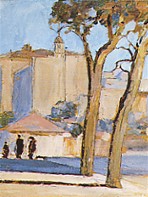
|
KRYCHEVSKY, VASYL H., b 12 January 1873 in Vorozhba, Lebedyn county, Kharkiv gubernia, d 15 November 1952 in Caracas, Venezuela. Outstanding art scholar, architect, painter, graphic artist, set designer, and a master of applied and decorative art. He received little formal education. Interested deeply in Ukrainian folklore and art history, he audited Mykola Sumtsov's and Dmytro Bahalii's classes at Kharkiv University. Working as an independent architect and artist, he achieved a national reputation by the time of the outbreak of the First World War. In 1917 he was a cofounder and the first rector of the Ukrainian State Academy of Arts. In the 1920s he taught at the Kyiv Institute of Plastic Arts and the Kyiv Architecture Institute. In 1927 he lectured for a year at the Odesa Art School, and then taught architecture at the Kyiv State Art Institute until 1941. After the war he lived briefly in Paris before emigrating in 1947 to South America. As a painter Krychevsky was deeply influenced by French impressionism. The pure and harmonious colors of his south-Ukrainian landscapes or Kyiv cityscapes (done in oils and watercolors) convey a haunting lyrical atmosphere... |
| Vasyl H. Krychevsky |
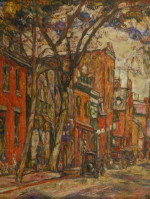
|
MANEVICH, ABRAM, b 25 November 1881 in Mstsislau, Belarus, d 30 June 1942 in New York. Painter. Born in a Jewish ghetto in Mstsislau, he moved to Kyiv in 1900 where he was discovered and supported by the Ukrainian scholar and museum director Mykola Biliashivsky who helped Manevich enrol in the Kyiv Art School. Biliashivsky also organized Manevich's first exhibition and helped to fund his studies at the Munich Academy of Arts (1905-7). Influenced by Paul Cezanne and other post-impressionists, Manevich, nevertheless, developed a uniquely individual style of landscape painting. He gained international recognition after his successful exhibition at the Durand-Ruel Gallery in Paris in 1913, but, having declined offers to move to London or New York, returned to Kyiv. He was one of the founding professors of the Ukrainian State Academy of Arts (1917-19). He had two solo exhibitions in Kyiv (1910, 1916). Manevich was noted for his masterful landscapes, particularly of Kyiv and small towns in Ukraine. He left Ukraine after his son was killed in 1919 by the troops of anarchist Otaman Danylo Zeleny. From 1920 he lived abroad and in 1922 he settled in the United States... |
| Abram Manevich |
_s.jpg)
|
KRYCHEVSKY, MYKOLA, b 24 November 1898 in Kharkiv, d 11 September 1961 in Paris. Impressionist painter; son of Vasyl H. Krychevsky and brother of Vasyl V. Krychevsky. After studying art with his father, and with Yosyp Bokshai in Uzhhorod, he studied painting in Prague at the Ukrainian Studio of Plastic Arts and the School of Industrial Design (from which he graduated in 1928). In 1929 he moved to Paris. An author of over 7,000 paintings, Krychevsky is best known for his watercolors: his scenes of Paris (such as On the Seine, 1934) and Venice (such as Venice, 1949) earned him international acclaim. He also painted landscapes of Ukraine from memory (eg, Autumn Landscape with a Church or Memories of Ukraine). His work was exhibited at the Salon des Independents in Paris, and solo exhibitions of his paintings were held in Lviv, Warsaw, Prague, Rome, Brussels, as well as in the United States and Canada. Krychevsky also designed stage sets for the Ruthenian Theater of the Prosvita Society (1921-3) and Oleksander Zaharov's company (1921-5) in Uzhhorod, and the Theatre des Arts (1939) and the Theatre Hebertot (1942) in Paris... |
| Mykola Krychevsky |
The preparation, editing, and display of the IEU entries about impressionism in Ukrainian painting was made possible by the financial support of the CANADIAN FOUNDATION FOR UKRAINIAN STUDIES.
ABOUT IEU: The Internet Encyclopedia of Ukraine is the most comprehensive source of authoritative information in English on Ukraine, its history, culture, geography, society, diaspora, and political administration. A project of the Canadian Institute of Ukrainian Studies, it contains thousands of carefully researched articles by some of the leading specialists in Ukrainian studies and other relevant disciplines. The textual content is complemented with tens of thousands of photographs, illustrations, maps, and tables as well as music files. At the same time, the IEU is a constant work in progress. At present, some 62% of the entire planned IEU database is available on the IEU website. New entries are being edited, updated, and added daily. But our ability to provide this information and the speed with which we can make it available to Internet users worldwide greatly depends on the availability of financial resources. You can actively contribute to the success of the Internet Encyclopedia of Ukraine by supporting our work morally and financially. Become an IEU supporter and help the CIUS in creating the world's most authoritative electronic information resource about Ukraine and Ukrainians!
|
Click Home to get to the IEU Home page; to contact the IEU editors click Contact. To learn more about IEU click About IEU and to view the list of donors and to become an IEU supporter click Donors. 2001 All Rights Reserved. Canadian Institute of Ukrainian Studies. |

